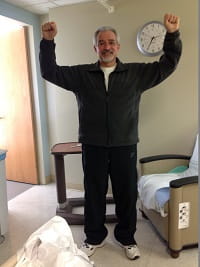The Challenge: Idiopathic Pulmonary Fibrosis (IPF)
In December 2011, Steve Constable and his family were busy getting ready to move into their new home. While packing, Steve began to feel tired and short of breath. At the time, he assumed he was just out of shape. But by January, as they settled into their new house, he could barely lift a few boxes without getting too tired. Steve’s family took notice and encouraged him to see a doctor.
After several visits with a local pulmonologist, Steve was diagnosed with idiopathic pulmonary fibrosis (IPF). IPF is a disease that causes scarring or stiffening of the lungs and makes every day activities difficult. While there is no known cause of IPF, symptoms include shortness of breath, weight loss, and fatigue.
After seeing his mother pass away from IPF, Steve knew just what to expect.
“I knew what the outcome was. I had about two to three years to live,” says Steve.
The Path to the UPMC Lung Transplant Program
Steve’s pulmonologist referred him to the UPMC Simmons Center for Interstitial Lung Disease. After a series of tests, his doctor suggested a lung transplant. Until that point, he had never realized that a lung transplant was possible.
Steve underwent his first transplant evaluation in 2013. Despite being very sick, he was still too healthy to be placed on the transplant waiting list. At that point, he became determined to do everything possible to stay healthy, both physically and mentally, while waiting for a transplant.
“I monitored my oxygen levels, made sure I ate well, and exercised at least once a day,” says Steve. “I was getting ready and preparing and at the time I wasn’t in bad shape at all.”
By late 2014, his condition became more complicated and he returned for a second transplant evaluation. One month later, on a snowy Monday morning, Steve received a call from a transplant coordinator letting him know that he had been placed on the transplant waiting list.
The Solution: A Lung Transplant
Due to his rare blood type, Steve was only on the waiting list for one day when a donor became available.
He underwent a transplant on January 28, 2015. While his recovery was not easy because of a complication with his vocal cord that required an additional surgery, Steve never lost faith in himself or the transplant team, and after only a few weeks, his condition began to improve.
“I had to learn to walk and eat all over again,” says Steve. “But once I got started I was able to see improvements every day and those first steps were incredible.”
The Results: Staying Healthy and Active
Since his transplant, Steve has returned home and is focused on staying healthy. He has gotten back to all of his normal hobbies, such as hunting, fishing, and spending time with his two young granddaughters.
Along with the support of his family, friends, and the transplant team, Steve believes that his physical preparation and his faith helped him through his transplant and saved his life.
“Before knowing that a lung transplant was an option everything just stopped, but now I have a renewed sense of hope and a future,” says Steve.
Steve’s treatment and results may not be representative of all similar cases.
Learn More About Lung Disease and Lung Transplant
UPMC Transplant Services:
UPMC Department of Pathology:
UPMC Health Library:

















